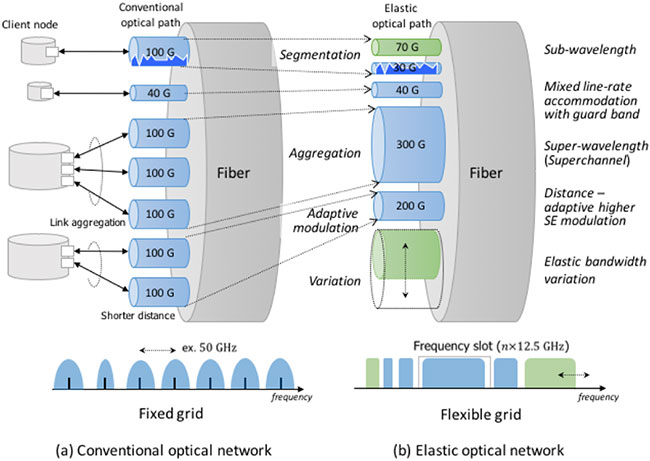Optical fiber transmission technology has played a very important role in supporting the exponential growth of the Internet. As the information society develops further, Internet traffic volume is expected to continuously increase. However, further increases in optical fiber spectral efficiency (SE) or increasing the number of bits per symbol will become more and more difficult due to the nonlinear Shannon limit (1). Since the low loss spectral range of widely deployed silica-based optical fibers is limited to ~10 THz, we are approaching the physical capacity limit of optical fiber transmission. As a result, it is expected that, in the near future, capacity crunch of fiber optic systems could become a bottleneck restricting continuous advancement of the Internet. At the 35th European Conference on Optical Communications (ECOC), held in Vienna in September 2009, the recipient advocated that it is important to develop a highly efficient optical networking technology that maximally utilizes optical network resources without waste(2), which can make up for the pace-down of transmission capacity increases. As an enabling technology, he clarified that elastic optical networking technology, which he and his colleagues at Nippon Telegraph and Telephone Corporation (NTT) originally proposed in 2008 (3), is quite promising. Elastic optical networking technology has indicated an important direction in which subsequent research and development activities for optical networks could proceed.
In conventional optical networks, optical channels are arranged at equal spacing on the fixed frequency grid, regardless of their bit rates and transmission distances (Fig 1(a)). On the other hand, in elastic optical networks, the necessary minimum spectrum is adaptively allocated to each optical channel according to the bit rate and the transmission distance (4) (Fig. 1(b)), and each optical channel is routed by bandwidth variable OXCs/ROADM (Optical Cross-connects/Reconfigurable Optical Add Drop Multiplexers) in the optical domain. As a result, efficient use of the spectrum resources in the optical network becomes possible and future ultra-high capacity optical networks employing optical channels with bit rates beyond 100 Gb/s can be developed in a flexible and economical manner. The recipient proposed the concept of elastic optical networks (EONs) and took the initiative in research and development of enabling technologies, including bandwidth-variable ROADMs, bandwidth-variable and adaptive-modulation transponders (4), routing and spectrum assignment algorithm(5), and thus pioneered a new research field in optical networking technologies. A number of academic papers were published in the field following his proposal of the EON concept. Terms such as "Elastic Optical Network" and "Routing and Spectrum Assignment," that were originally applied by the recipient, have become established as academic terms and are now widely utilized.
EON has been widely recognized as an important technology for future optical networks by not only academia but also industry, and significant research and development efforts are being conducted around the world. International standardization activities related to EON have been pursued at the ITU-T (International Telecommunication Union Telecommunication Standardization Division). In 2012, regarding the adaptive spectrum allocation concept of EON, the ITU-T updated its G.694.1 recommendation to include the flexible grid option based on a newly introduced frequency slot concept. In addition, the ITU-T updated its G.709 recommendation to accommodate a new flexible OTN interface, OTUCn, for client signals greater than 100 Gb/s.
As mentioned above, the recipient invented the basic concept of EON and initiated extensive research activities on optical networks. His papers, including (4), (5) and (8), have resulted in numerous citations. Based on his achievements, he was awarded the ITU-T Kaleidoscope Academic Conference Best Paper Award (2010), the IEEE Communications Society Asia-Pacific Board Outstanding Paper Award (2013), the IEICE Communications Society Tutorial Paper Award (2010), and the IEICE Communications Society Best Paper Award (2011). He also received a Fellow award from the IEICE, and he is a Senior Member of the IEEE. As described above, his achievements in optical networking technology are highly remarkable and are deserving of the IEICE Achievement Award.
Fig. 1 Flexible spectral allocation in an elastic optical network (4)
(a) Conventional fixed frequency grid, (b) Flexible frequency grid developed for elastic optical networks
References
- A. Chraplyvy, gThe coming capacity crunch,h In Proc. Vienna, Austria,35th European Conference on Optical Communication, Vienna, Austria, 2009.
- M Jinno, H Takara, B Kozicki, gDynamic optical mesh networks: drivers, challenges and solutions for the future,h In Proc. 35th European Conference on Optical Communication, 7.7.4, Vienna, Austria, 2009.
- M Jinno, H Takara, B Kozicki, Y Tsukishima, T Yoshimatsu, T Kobayashi, Y Miyamoto, K Yonenaga, A Takada, O Ishida, S Matsuoka, gDemonstration of novel spectrum-efficient elastic optical path network with per-channel variable capacity of 40 Gb/s to over 400 Gb/s,h 34th European Conference on Optical Communication, 2008.
- M. Jinno, H. Takara, B. Kozicki, Y. Tsukishima, Y. Sone, and S. Matsuoka, gSpectrum-Efficient and Scalable Elastic Optical Path Network: Architecture, Benefits, and Enabling Technologies,h IEEE Commun. Mag., 47, I66-73, 2009.
- M. Jinno, B. Kozicki, H. Takara, A. Watanabe, Y. Sone, T. Tanaka, and A. Hirano, gDistance-Adaptive Spectrum Resource Allocation in Spectrum-Sliced Elastic Optical Path Network (SLICE),h IEEE Commun. Mag., 48, 138-145, 2010.
- M. Jinno, T. Ohara, Y. Sone, A. Hirano, O. Ishida, and M. Tomizawa, gIntroducing Elasticity and Adaptation into the Optical Domain toward More Efficient and Scalable Optical Transport Networks,h in Proc. ITU-T Kaleidoscope Academic Conference, 2010.
- M. Jinno, H. Takara, Y. Sone, K. Yonenaga, and A. Hirano, gMulti-Flow Optical Transponder for Efficient Multi-Layer Optical Networking,h IEEE Commun. Mag. 50, 56-65, 2012.
- O. Gerstel, M. Jinno, A. Lord, S. J. B. Yoo, gElastic Optical Networking: a new dawn for the optical layer,h IEEE Commun. Mag., 50, S12-S20, 2012.
- M Jinno, H Takara, K Yonenaga, A Hirano, gVirtualization in optical networks from network level to hardware level invited,h Journal of Optical Communications and Networking 5 (10), A46-A56, 2013.
- M Jinno, gElastic Optical Networking: Roles and Benefits in Beyond 100-Gb/s Era,h Journal of Lightwave Technology, 2017.


